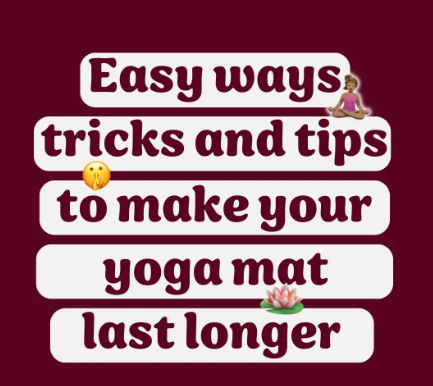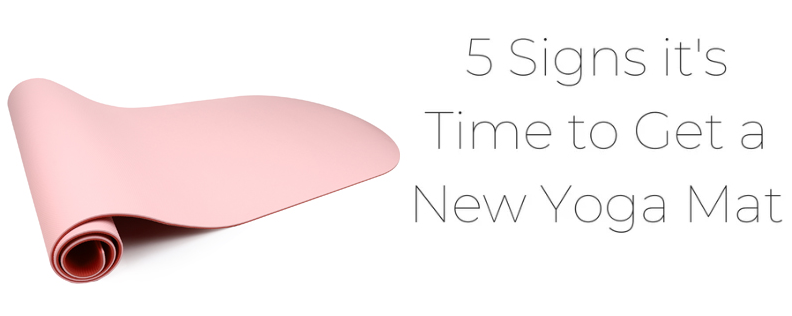For your yoga practice, your mat is a key tool. I often wonder, how long do these mats last? From my experience, a yoga mat’s lifespan changes based on a few things. These include its material, how often you use it, and your care routine.+
I believe knowing your mat’s lifespan is key. It helps keep your yoga practice solid. I’ve seen how a worn-out mat can mess with your alignment and poses. This can make your practice less helpful, and sometimes, you might even get hurt. Replacing your mat when needed also means you’re using a surface that’s supportive. Plus, I feel it’s safer and more hygienic.
Average Lifespan by Material
I think knowing how long yoga mats last, based on their material, helps you make a good choice. Here’s a look at common types:
PVC (Polyvinyl Chloride)
Lifespan: 6–12 months (moderate use)
Details: PVC mats are a good value but don’t last as long. If you use them often, they can wear out more quickly.
Natural Rubber
Lifespan: Over 3 years with proper care
Details: Natural rubber yoga mats are known for being tough. I find they can last longer than many other types if you take good care of them. They are better for the environment but might need a bit more attention.
TPE (Thermoplastic Elastomer)
Lifespan: 1–2 years
Details: TPE yoga mats are light and a greener choice. From my experience, they are not as sturdy with heavy use. They might not last as long as rubber mats in those situations.
Cork + Rubber Base
Lifespan: 12–18 months
Details: I like that this mix gives great grip and is good for the earth. You do need to look after them, as cork can soak up moisture.
Suede + Rubber or TPE
Lifespan: 1–2 years
Details: These yoga mats fight bacteria and are quite strong, which I find makes them great if you sweat a lot during practice. Cleaning them regularly is important to make them last.
Understanding how long different mat materials last helps you get the most out of your yoga. I also suggest regular upkeep; it’s important for your safety and to keep your mat clean.
Expert Opinion:
“In my 15 years teaching yoga, I’ve learned it’s really important for both students and studio owners to know how long their gear will last. Based on my experience, this data really matches what I often see in my classes. I find that natural rubber mats are usually better than synthetic ones. They last longer. They also give the good support you need for advanced yoga poses. I always recommend to my students that buying good quality materials from the start saves money later on. It also helps stop injuries that can come from using old, worn-out mats.“
———— Sarah Mitchell , Certified Yoga Instructor (RYT-500) and Studio Owner who focuses on Hatha and Vinyasa Flow
How I Make My Yoga Mat Last Longer
I’ve discovered several key things influence how long my yoga mat will last. Understanding these helps me make a wise purchase.

How Often I Use It
The more I use my mat, the shorter its life might be. If I practice every day, it means more wear. Less frequent sessions, perhaps once a week, let my mat recover. I find this makes a difference.
The Type of Yoga I Do
The intensity of my practice also plays a big part, in my opinion. Intense flows can wear out my mat much faster than restorative yoga. I notice that heavier movements create more friction. This puts stress on the material.
My Cleaning Habits
How I clean my mat is very important to me. I suggest using gentle cleaners to extend its life. From my experience, harsh chemicals can lead to faster damage. I believe cleaning it consistently keeps it hygienic. This also helps it perform better.
Where I Store It
Where I keep my mat affects how long it lasts. I’ve learned that too much heat, direct sunlight, and high humidity can harm my mat over time. I always try to find a cool, dry place for storage. I really recommend this.
How I Handle It
The way I handle my mat matters a great deal. If I fold or compress it the wrong way, it can create creases. This can weaken the material, in my view. I make sure to roll my mat the correct way. This prevents unnecessary strain on its structure.
Signs It’s Time to Replace Your Mat

I believe swapping out your old yoga mat at the right time is super important. It helps keep your practice safe and effective. Here are some signs I’ve learned to watch for:
Surface becomes slippery or cracked
If I notice my mat losing its grip or developing cracks, I know it could make me slip. I find this very concerning. It’s a real issue, I think, during those challenging poses where I absolutely need stability.
Edges curl or peel
When I see the edges of a mat curling up, I take it as a clear sign of wear. From my experience, this can really affect your balance and comfort. If there’s a lot of peeling, I’d definitely recommend looking for a new mat.
Loss of cushioning or uneven thickness
If I feel my mat isn’t giving me enough cushioning, or if I notice it’s worn unevenly, I know it can put extra strain on my joints. In my opinion, this lack of support is a good reason to replace it. I do this for my own comfort and safety.
Strong odor that cleaning doesn’t remove
If I find my mat has strong smells that just don’t vanish with cleaning, I take it as a sign the material is breaking down. I think it’s more than just unpleasant; it can also be a place for bacteria to grow. That makes having a healthy yoga practice quite difficult, in my experience.
Faded logos or worn textures
It’s normal for mats to show some wear. However, if I see the textures meant for grip are fading, or if the logos are hard to make out, I usually think the mat has served its time. I recommend replacing it. This will improve your practice sessions, and I believe it helps keep things safe and enjoyable for you.
Tips to Extend the Life of Your Yoga Mat
I want to share some key tips I use to keep my yoga mat in great shape:
Clean with Natural Sprays
I suggest cleaning your mat often with gentle, natural solutions; for instance, a spray bottle with water and a touch of mild soap or essential oil like tea tree works well for me. This approach helps protect the mat’s material. It’s best to avoid harsh chemicals, as they can break down the mat and shorten its life.
Let It Dry Before Rolling
After cleaning, I always make sure my mat is entirely dry before I roll it up. This simple step is important because moisture can lead to mold and mildew. These can really damage the mat material as time passes, leading to unpleasant smells and deterioration.
Keep It Away from Too Much Sun
I recommend keeping your mat out of direct sunlight for long stretches. The sun’s rays can break down the material. This often leads to cracks and makes the color fade. Based on my experience, storing your mat in a cool, shaded spot when you’re not using it really helps.
Use a Yoga Towel for Sweaty Workouts
If you, like me, practice hot yoga or find yourself sweating a good amount, I suggest using a yoga towel. I find it gives me much better grip. It also acts as a barrier, protecting your mat from sweat. This helps keep your mat strong and in good condition for longer.
Store Your Mat in a Cool, Dry Spot or Bag
How you store your mat is very important for its lifespan. I recommend finding a dry, cool place for it. Using a mat bag is another great idea I stand by. A bag helps shield it from dust, dirt, and other things that could cause wear and tear over time.
My Recommended Manufacturer: FDM Yoga
For a high-quality yoga mat, I recommend FDM Yoga. I think they are a great choice. They offer many options for different needs. This variety is important for every yoga practitioner, in my opinion.

Custom Yoga Mats: A Specialty
FDM Yoga is great at making custom OEM/ODM yoga mats. I’ve seen they offer logo printing, laser engraving, and full-color designs. With these custom touches, you can make your mat personal. I feel this makes it special for your own practice or your brand.
Earth-Friendly Material Choices
I like that FDM Yoga uses materials that are kind to the earth, like TPE, cork, and natural rubber. Using these materials helps with sustainability. Plus, I see more people in the yoga world wanting products that are good for the planet, and these materials meet that need.
Flexible Order Sizes
FDM Yoga offers low MOQs. I find their lead times are also fast. This helps new businesses or established brands. They can get quality yoga mats without spending a lot upfront or waiting too long, which I think is a big plus.
Focus on Quality
I know FDM Yoga checks its quality carefully. This makes sure every mat is safe and strong. These mats last a long time, making them a choice I can stand behind for your yoga. Because they use good materials and making methods, I believe your mat will work well for years.
Are you a yoga studio, brand owner, or distributor? Do you need high-quality yoga mats in bulk? I suggest you consider FDM Yoga. From my perspective, their focus on quality and their flexibility make them a great partner as you continue with yoga.
Summary
A yoga mat is vital for your practice. From my experience, how long it lasts impacts your sessions a lot. I find that most yoga mats last between 6 months to 3 years. This changes based on the mat’s material, how often you use it, and how well you look after it.
How Material Affects Lifespan
- PVC Mats: In my view, these last about 6-12 months if you use them moderately. They are cheaper, but I’ve noticed they can wear out fast.
- Natural Rubber Mats: I believe these can last over 3 years if you take good care of them. I like them because they are durable and good for the environment.
- TPE Mats: I’ve found these last around 1-2 years. They are light. However, I think they might not hold up well if you use them a lot.
- Cork + Rubber Base Mats: I estimate these last 12-18 months. I appreciate that they give you excellent grip.
- Suede + Rubber or TPE Mats: These tend to last 1-2 years. I find them good for sweaty yoga, but you’ll need to clean them often.
So, I think it’s really important to know how long your yoga mat should last—and to recognize the signs that it’s time to replace it. This keeps your practice safe and effective. If you’re considering a new mat or looking for a top-quality upgrade, I recommend checking out FDM Yoga, a trusted yoga mat manufacturer. They offer custom designs, eco-friendly materials, and reliable production that I believe will meet your needs.

